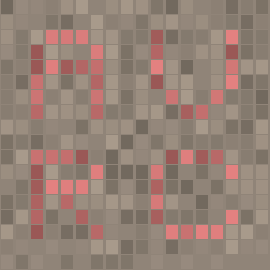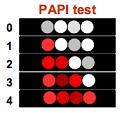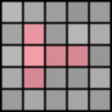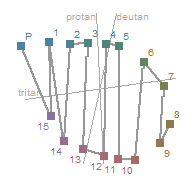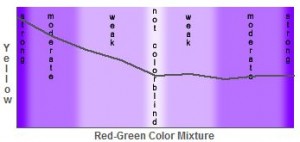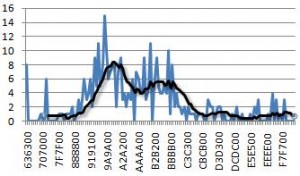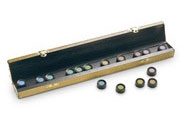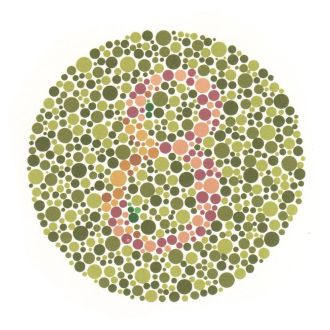
Most people relate the term color blindness test to the dotted pictures or even to the name Ishihara.
But this is not the only one, not the best one, definitely not the most current one, and most often an unsuitable test which is still used all around the world.
This part of the Color Blind Essentials series focuses on the different possibilities to test color vision, how they work, what they can be used for and lists some of the well-known and used tests. There will be no conclusive enumeration as there are just to many tests around, with a lot of them not available anymore but still in use.
First color blindness tests
Already in the 17th century Turberville found differences in some individuals color naming, which was definitely one of the first color blindness tests. About one hundred years later John Dalton described in detail his color vision and also tested other people with some colored ribbons which had to be named as well. At this time most often color vision deficiency was reported simply by subjective descriptions.
In 1837 August Seebeck used some more advanced technique. He used a set of more than 300 colored papers and let people match or find a closely related color to a sample color. This type of color vision test abandoned the naming of colors, which differs a lot between test persons. Through Seebeck’s color blindness test two different types of red-green color blindness and a broad severity scale were discovered. Holmgren adopted this kind of test in 1877 by using skeins of wool. The Holmgren wool test was widely used and even commercially available more than one hundred years later.
The following two developments happened around the same time. They led to modern color vision deficiency testing.
- John William Strutt Rayleigh developed a precise color matching test. This match—still known as Rayleigh match—is not only the base of modern anomaloscopes but also made him discover dichromatism and anomalous trichromatism.
- Dr. J. Spilling published the first painted set of pseudoisochromatic plates. They were the predecessors of the famous Ishihara plates, which were produced the first time in 1917.
The different color vision deficiency test forms
Anomaloscope
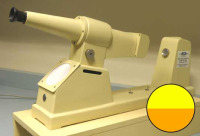
The anomaloscope provides the most accurate possibility to test the severity of color blindness and distinguish between dichromats and anomalous trichromats.
It is based on the Rayleigh match: A mixture of red and green light sources has to be matched with a yellow light source. Through the matching range it is possible to discover all different types of red-green color vision deficiency. Some of the anomaloscopes also include the Moreland match (blue-green) to test for tritan defects.
If you are a dichromat you will be able to make a match for all red-green mixture ratios. Anomalous trichromats don’t accept the normal match and the distance of their match indicates the severity of their deficiency. On the other side, if you suffer a protan vision deficiency you will use much more red to match the colors compared to people with a deutan defect, which use more green in their mixture.
In 1907 the Nagel anomaloscope was introduced and is still known as one of the best. Unfortunately it is not produced anymore. Other well known instruments are the Neitz anomaloscope, the HMC (Heidelberg Multi Color) anomaloscope or the Pickford-Nicolson anomaloscope.
Pseudoisochromatic plates
Pseudoisochromatic plates are the most famous type of color blindness test. Most people know them under the name Ishihara plates test, because Dr. Shinobu Ishihara was one of the first persons who designed a very reliable plate test, introduced in 1917. He produced different test sets. Ishihara plates are still widely used all around the world.
The copunctual points build the source for this type of color vision test. The fact that colorblind people can’t distinguish colors along the confusion lines is used to build a pattern of differently colored dots. If you are color blind you won’t spot the dots which are shifted along the confusion lines and therefore numbers, letters, lines or anything else can be hidden from you.
There exist four different type of plates:
- Vanishing design: Only people with good color vision can see the sign. If you are colorblind you won’t see anything.
- Transformation design: Color blind people will see a different sign than people with no color vision handicap.
- Hidden digit design: Only colorblind people are able to spot the sign. If you have perfect color vision, you won’t be able to see it.
- Classification design: This is used to differentiate between red- and green-blind persons. The vanishing design is used on either side of the plate, one side for deutan defects an the other for protans.
Why can colorblind people see something which is not visible for people with perfect color vision?
If you are colorblind you are not distracted by hue differences along the confusion lines. You will be more focused on lightness differences. This two different facts are used to design the hidden or invisible plates.
Besides the most famous Ishihara plates exists in a standard version of 38 plates, a shorter version of 24 plates and a concise test containing 14 plates. Ishihara plates can only be used to classify red-green color vision deficiencies. Tritan defects can not be evaluated by these tests.
The other well known pseudoisochromatic test plates are the 24 HRR plates by Hardy, Rand and Ritter. This test was first produced in 1954 and can be used the classify all three different forms of color vision deficiency. There also exist a lot more of such tests but none of them is widely used. Even some electronic vision test equipments include certain pseudoisochromatic plates as a quick color vision test. But none of them is very accurate to get a concise test result.
Arrangement tests
Arrangement tests are also based on the theory of copunctual points. In contrast to the static pseudoisochromatic plates where you have to spot a path or number, an arrangement test is dynamic.
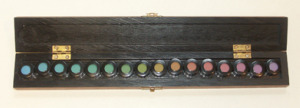
Every such test consists of a certain number of colored discs or plates which have to be arranged in the correct order, starting from a pilot plate. The colors are chosen around the white point and because colorblind people can not distinguish colors along certain lines they will arrange the discs completely different compared to somebody with normal color vision.
The most well known test was introduced by Fransworth in the forties of the last century and is called Farnsworth D-15 arrangement test. As the names suggests this test includes 15 colored plates which have to be arranged in the correct order. You can try an online version of this test right here at Colblindor: Color Arrangement Test.
Some other well known tests in this category are the Lanthony desaturated D-15 test, which is used to classify milder forms of color blindness and the Farnsworth-Munsell 100 hue test. This test includes 100 different plates which have to be arranged in batches of 20 plates. Unfortunately the results are not that better compared to the 15 plates versions.
Lanterns
The last well known type of tests was introduced by railway companies which discovered, that some of their employees couldn’t distinguish certain signal lights. Lantern tests are specially designed to simulate signals and are therefore most often used as vocational tests.
Compared to the other tests with lanterns you are testing the required ability directly. They are robust and have a high practical value. On the other side you can’t reveal much of the nature and severity of the color vision defect.
- Holmes-Wright lanterns: This lantern includes two different green, two red and a white light. Lights are shown in pairs of two, low or high brightness, either vertically or horizontally aligned. The test person is asked to name the colors.
- Farnsworth lantern (Falant): This is the standard test in the US. It is comparable to the Holmes-Wright lantern but is specially designed to pass people with a mild form of color vision deficiency.
- Beyne lantern: France.
- Giles-Archer lanterns: UK.
- Edridge-Green lantern: UK.
The following table shows an overview of the different main test types for color blindness and compares them in certain dimensions. Every test type is graded from (-) not capable to (+++) excellent capability.
| Anomaloscope | Plates | Arrangement | Lanterns | |
|---|---|---|---|---|
| Identifying CVD | +++ | +++ | – | + |
| Classifying type | +++ | ++ | ++ | – |
| Grading severity | +++ | + | ++ | + |
| Classifying dichromat anomalous trichromat |
+++ | – | – | – |
| Occupational suitability | – | – | +++ | +++ |
Unfortunately Ishihara plates are used much to often to check for occupational suitability. Lanterns or certain arrangement tests would be much better in this case. And if you like to have a precise diagnosis of your color vision deficiency there is no way around an anomaloscope.
The future of color vision testing
Today in our digital world one might think, why don’t we have some simple computer based color blindness test. Unfortunately this is not as simple as it looks like. There are two main problems:
- Computers displays just make use of three main colors red, green and blue (RGB). Every other color gets mixed from those three colors. The anomaloscope and lantern tests use different light sources which can’t be simulated by a display.
- Every computer display has a different color range it covers, little differences in light sources, different brightness and more. This causes different test results. Only calibrated computers can be used to perform such computer based tests.
The City University in London developed a computer based color vision test which is also based on the same principal as pseudoisochromatic plates and arrangement tests. The main difference is that the colors are constantly changing which gives some really good results. Just recently they used their test to check color vision in pilot candidates and it looks like as the Color Assessment & Diagnosis Test (CAD Test) could become a standard screening instrument for color vision testing. At least for certain professions, where color vision is critical but people with a mild form of color vision still perform perfectly.
There are also some genetic screenings available. But even such a simple impairment as color blindness is not easy to detect in the genes. So every genetic test always needs some physical tests in parallel to get a proper and concise test result.
Color naming would be a very simple test to identify color blindness. But for most cases this is just to simple, to unspecific and not reliable enough. Therefore color naming can be used to check if you have a moderate to strong color vision deficiency but not for a detailed classification of your color vision deficiency.
The next part of the Color Blind Essentials series focuses on how color blindness can affect your everyday life.

